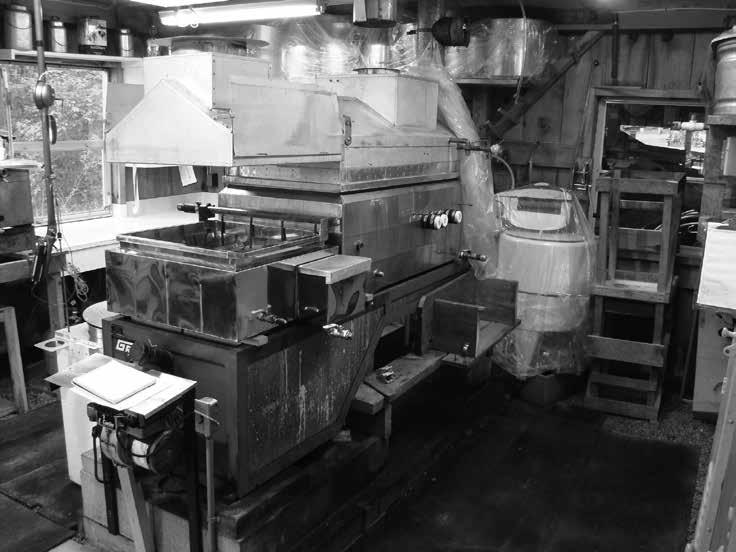
4 minute read
Sm llidgePeter
Ask A Professional
Peter Smallidge
Advertisement
Peter Smallidge
Landowner questions are addressed by foresters and other natural resources professionals. Landowners should be careful when interpreting answers and applying this general advice to their property because landowner objectives and property conditions will influence specific management options. When in doubt, check with your regional DEC office or other service providers. Landowners are also encouraged to be active participants in Cornell Cooperative Extension and NYFOA programs to gain additional, often site-specific, answers to questions. To submit a question, email to Peter Smallidge at pjs23@cornell.edu with an explicit mention of “Ask a Professional.” Additional reading on various topics is available at www.forestconnect.info
Assessing a maple woods for sap and syrup production
Question:
I’m interested in using my woods to be productive and generate income, but the trees aren’t big enough to think about a harvest. I saw advertising for maple weekend, and it made me think about sap and syrup. Is this an option for my woods? (Scott F., STC) three strategies. These strategies range from significant owner investment to no direct investment by the owner. With the greatest investment, the owner is the producer. As producer the owner installs a sap collection system (usually tubing, infrequently buckets for commercial production), a way to process the sap, and a plan to market the syrup and any related maple products. This strategy has the greatest investment and the greatest return. An intermediate strategy is for the owner to collect the sap and sell it to a nearby producer. The owner thus needs only to invest in the collection system and a manner or strategy to transport the sap. The least investment is for the owner to lease trees to a maple producer who does the work and pays to the owner, usually, on a per tap basis. All these options may allow the owner to take advantage of a reduction in land taxes through the agricultural district laws.
Answer:
Many woodland owners enjoy working their land with the intent of generating income. While timber harvesting is common, harvesting is episodic and may not be suitable for any given property at any particular point in time. Maple production is compatible with goals that include timber and firewood harvesting, and in some cases offers additional economic and personal opportunities for the owner. Woodland owners thinking about maple production will need to consider the characteristics of their property, and the characteristics of the section of woods where sap is collected, called the sugarbush (Figure 1).
Maple production, the collection and processing of maple sap into syrup or value-added products, can take one of
Before thinking about the specific attributes of the woods, an owner needs to consider several propertylevel conditions of their land and ownership objectives before venturing into maple production. The list is similar to the considerations that would be made before starting any new enterprise, and the full consideration is beyond the scope of this article. The owner should consider their proximity to a market, their ability to market products such as sap or syrup, whether they would accept tubing in their woods (which usually remains throughout the year, Figure 2), their
Figure 2. Maple tubing is the standard approach for collecting sap for the commercial (and profitable) production of syrup. Tubing system designs allow for ease of access. Tubing usually remains in the woods throughout the year.

willingness to make a multiyear commitment especially if they lease their trees, their availability and capacity to participate in a busy spring season, and their ability to finance some initial investment for supplies and equipment. Owners considering a maple enterprise should spend time with other producers and join the NY Maple Syrup Producers Association. They could also participate in the annual summer training called Cornell Maple Camp, announced at www. CornellMaple.com and usually held at Cornell’s Arnot Forest near Ithaca.
The economics of maple versus timber can be either simple or complex. On the simple side of this consideration is a woods with maple trees that are mostly 10 to 16 inches in diameter. If
continued on page 18 the comparison is maple versus timber, these smaller trees can begin producing an annual return immediately, but might be a few decades from a timber revenue event. The net present value and collective revenue through time is in the favor of maple sap/syrup production. If the trees are 18 to 22 inches and high quality stems, the economics would likely favor timber. This isn’t all or nothing, because the trees used for maple sap and eventually can be sold as “tap hole” maple logs to buyers with markets for specialty lumber (Figure 3). The complexity arrives because some owners with high-value timber trees are reluctant to harvest trees, they want to maintain a high canopy, or want an activity that is annual and binding across generations of the family. The analysis is further complicated because there will be high and lesser value trees, and by adding the potential for increased revenue from maple value-added products such as maple cream, granulated maple sugar, maple candy, or maple cotton candy.
Having considered the broad questions of whether to begin a maple enterprise, there are several characteristics of your woods that will help you identify the best place to begin, or which section of your property to avoid. The assessment
Figure 3. Lumber made from previously tapped trees is called “tap hole maple” and used in specialty wood products such as tables, cabinets, wainscoting, and picture frames.


Figure 4. Maple producers attending Cornell Maple Camp learned how to use an angle gauge to estimate the number of tapable trees. The abundance of tap trees per acre influences efficiency.









